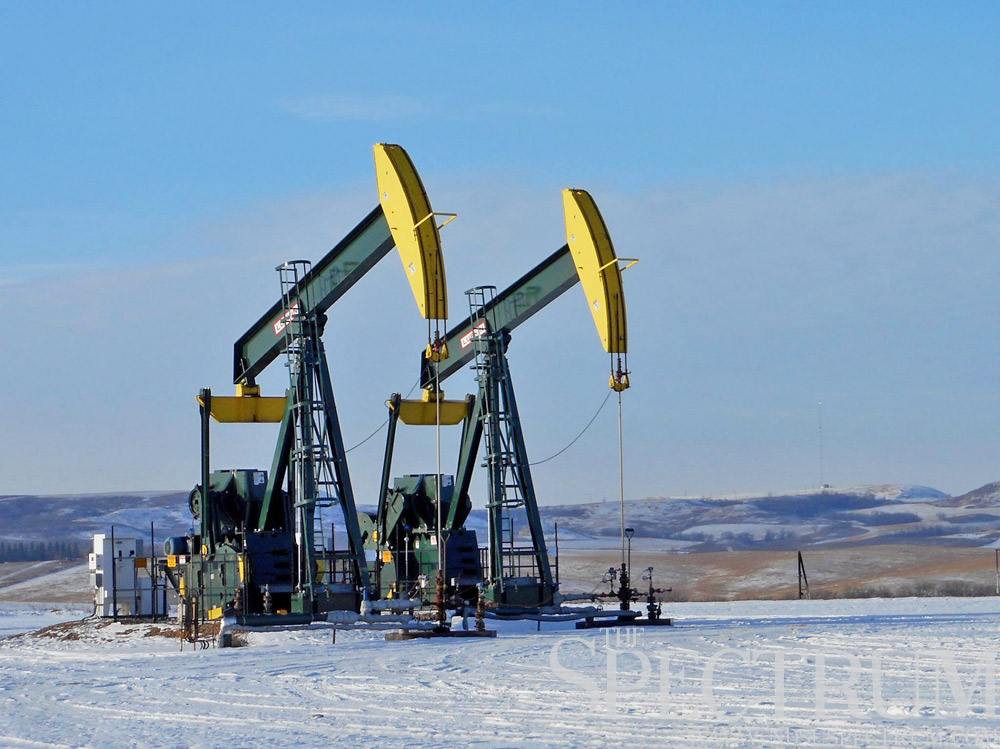
Hess Corporation pumpjacks nod away on a well pad south of Watford City, N.D., last month.
The Bakken region may be over 200 miles from Fargo, but that doesn’t mean North Dakota State is free from its effects.
A state budget shortfall of over $1 billion due to slumping oil prices and agriculture commodities is cutting all state agencies’ budgets by 4.05 percent, as ordered by Gov. Jack Dalrymple. NDSU must cut over $6.4 million from its budget for the 2015-17 biennium. Provost Beth Ingram said in a Feb. 1 email to campus that the university will delay and reevaluate funding to several university operations, including the Grand Initiative Challenge, a research program.
North Dakota’s oil boom began in 2006 and effectively ended Feb. 1 with the unforeseen budget shortfall. Here are 14 facts about the oil boom.
1. Oil was discovered in North Dakota in spring 1951. Two oil booms in the 1950s and ’80s preceded the 2000s’ North Dakota oil rush.
2. North Dakota’s oil-rich Bakken region is generally located north of Interstate 94 and west of Highway 83.
3. North Dakota leads second in the nation for oil production, behind Texas.
4. North Dakota has produced over 1 million barrels of oil daily since April 2014. A barrel of oil is equal to 42 gallons.
5. Bakken shale oil is highly explosive with gases much more combustible than other oil from 86 locations around the world, a Wall Street Journal analysis found.
6. Oil prices hit a high for North Dakota in July 2008 with $136.29 a barrel. North Dakota light sweet crude stood at $19.15 Friday.
7. Slumping oil prices come from a number of causes, the New York Times reported, including Middle East competition for Asian markets, low demand from weak European economies preferring energy-efficient vehicles and rising oil production and exports from Canada and Iraq. Oil prices are projected to recover but “not anytime soon,” the Times reported.
8. Williston, N.D., the city at the center of the Bakken region, grew from 12,000 to 33,000 people between 2000 and 2014. Over 2,000 people have left the boomtown since 2014 due to slumping oil.
9. The oil boom brought environmental challenges to Theodore Roosevelt National Park’s three units near Medora and Watford City, N.D., as light pollution, oilfield noise and well sites threatened the park’s peace and viewshed.
10. Safety of oil transportation by rail has created problems and disasters for North Dakota and elsewhere as explosions resulting from derailments near Casselton and Heimdal, N.D., since 2013 have grabbed international headlines. A train carrying North Dakota crude oil derailed in Lac-Mégantic, Quebec, killing 47 people in an explosion in 2013.
11. Crime surged in western North Dakota after people and oilfield workers flocked to western North Dakota since 2006. James Henrikson is currently on trial for masterminding several state and interstate murders and murders-for-hire related to his Bakken region enterprises, business dealings in which Tex Hall, former Three Affiliated Tribes chairman, was involved.
12. In 2010, state voters approved North Dakota’s Legacy Fund, a reserve fund of $3.5 billion derived from state oil revenues. The Legacy Fund cannot be touched until 2017.
13. Improved infrastructure as a result of heavy traffic and housing woes has made now “the prime time to travel western North Dakota,” a state tourism official said last summer.
14. North Dakota’s 2000s oil boom was hugely successful due to advancements in oil recovery technology, including hydraulic fracturing and horizontal drilling to unlock oil trapped in Bakken shale.

This article is not very informative. Looks like you just cut and pasted headlines. Maybe you should tour the bakken and do some research. Go Sioux!
Here’s an idea…instead of putting our firefighters, children, and towns, in the way of 350 foot fireballs, & spending taxpayer money to prepare for the next Lac-Megantic; perhaps the Bakken producers in North Dakota should be made to remove the explosive gases, like propane, butane, ethane, and methane, from the flammable crude, before pouring the whole concoction into a hundred 30,000 gallon tubes, and running them through our towns. It’s called stabilization, and the oil industry has been doing it since the world was black & white.